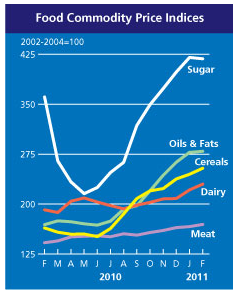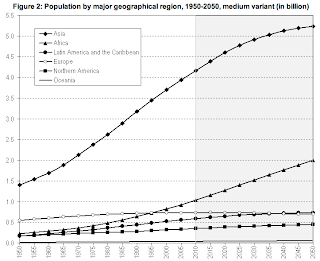
This article was last updated on May 19, 2022
Canada: ![]() Oye! Times readers Get FREE $30 to spend on Amazon, Walmart…
Oye! Times readers Get FREE $30 to spend on Amazon, Walmart…
USA: ![]() Oye! Times readers Get FREE $30 to spend on Amazon, Walmart…
Oye! Times readers Get FREE $30 to spend on Amazon, Walmart…
 Last week, the media was all abuzz about recently released data showing that food prices have reached an all-time high. In this posting, I’ll give a bit of background information about the source of this data.
Last week, the media was all abuzz about recently released data showing that food prices have reached an all-time high. In this posting, I’ll give a bit of background information about the source of this data.The Food and Agriculture Organization (FAO) of the United Nations released its monthly Food Price Index (FFPI) for the month of February 2011 that showed an increase of 2.2 percent from January. The FFPI reached 236 points, the highest level it has reached in both real and nominal terms since the FAO started tracking prices in January 1990. Here’s a graph showing the rise in the overall price of food since the inception of the FFPI:
The FAO’s Food Price Index is "a measure of the monthly change in international prices of a basket of food commodities. It consists of the average of five commodity group price indices (representing 55 quotations) weighted with the average export shares of each of the groups for 2002 – 2004.". The five food groups studied include cereals, dairy, oils and fats, met and sugar. In the month of February 2011, the prices of all commodity groups rose with the exception of sugar. Here’s the breakdown of the five groups:
1.) The Dairy Price Index rose the most among the five groups, it increased 4 percent from the previous month but is still off its all time high in November 2007 mainly because of strong product demand.
2.) The Cereal Price Index rose 3.7 percent from the previous month, the second highest increase among the five groups and the highest since July 2008. The price of maize rose the most due to strong demand and tight supplies while prices for wheat rose only slightly and the price of rice fell slightly.
3.) The Meat Price Index rose 2 percent from the previous month due to higher prices for hog and sheep meat. The price of beef has remained stable due to import disruptions in several markets.
4.) The Oils and Fats Price Index rose only marginally but is now just below the peak in June 2008. A recovery in the global supply of these products is responsible for the small price increase.
5.) The Sugar Price Index fell slightly from the previous month but are still 16 percent higher than this time last year due to tight supplies.
Here is a graph showing the individual food group indices for the past two years:
Now, let’s look at a report published by the United Nations Department of Economic and Social Affairs back in 2008. In this report entitled "The 2008 Revision of the World Population Prospects", the United Nations estimates the projected population of the world to the year 2050 based on several variants. These variants include changes to the world’s fertility rate using the current constant fertility rate as well as low, medium and high fertility rate scenarios. Here is a graph showing their projected world population to the year 2050:
Notice how in the medium fertility variant, the world’s population will reach 8.57 billion by 2035, a 24 percent increase in 25 years over the world’s current population of 6.904 billion (according to the United States Census Bureau).
Here are the regions in the world where the United Nations anticipates the population growth to be the greatest and the least:
It’s not terribly surprising that the Asian region is going to be responsible for the lion’s share of the world’s population growth over the next four decades.
Robert Malthus was born in 1766 in Dorking, south of London England. In 1805, he was appointed professor of Political Economy at Haileybury, a college run for the education of civil servants by the East India Company. In 1798, Malthus wrote an essay entitled "An Essay on the Principle of Population as it Affects the Future Improvement of Society with Remarks on the Speculations of Mr. Godwin, M. Condorcet, and Other Writers." Here is a quote from Chapter 1:
“I think I may fairly make two postulata.
First, That food is necessary to the existence of man.
Secondly, That the passion between the sexes is necessary and will remain nearly in its present state.
These two laws, ever since we have had any knowledge of mankind, appear to have been fixed laws of our nature, and, as we have not hitherto seen any alteration in them, we have no right to conclude that they will ever cease to be what they now are, without an immediate act of power in that Being who first arranged the system of the universe, and for the advantage of his creatures, still executes, according to fixed laws, all its various operations.”
Here is another quote from Chapter 1:
"Population, when unchecked, increases in a geometrical ratio. Subsistence increases only in an arithmetical ratio. A slight acquaintance with numbers will shew the immensity of the first power in comparison of the second."
Malthus so presciently observed that the world’s population increases at a far greater rate (geometric progression – 1, 2, 4, 8, 16…) than its production of food (arithmetic progression – 1, 2, 3, 4, 5….). He notes, quite correctly, that the passion between the sexes is unlikely to diminish over time and that the natural rate of population growth is likely to continue unabated.
When we put the recent increases in the price of food into the context of population growth, one has to wonder when the growth in humanity will outstrip its ability to produce ever increasing amounts of food and that increasing demand for a relatively fixed supply of food (particularly in some parts of the world) will lead to long-term food price inflation. The widespread use of hydrocarbon-based chemical fertilizers and pesticides has greatly increased agricultural output as has the addition of hydrocarbon-based mechanization especially over the last century. This has kept food supply growing in tandem with population growth One issue that will impact the supply of food, however, is out of mankind’s control; the potential for massive climate change over the coming decades. Certainly, it is possible that areas that are not currently farmable may become so as climate changes and as temperatures warm. Equally likely, however, is the opportunity for the spread of diseases and pests into areas where they have not been historically endemic. As well, unexpected frosts, droughts and floods may destroy crops in areas that have been normally considered prime agricultural lands. If, over the next 25 years, the massive population growth as projected by the United Nations and a levelling off of the increases in agricultural output combine, portions of the the world’s populace could be in for a perfect storm of misery.
Only time will tell whether Malthus’ thesis was correct but if the world continues along its current path, we may find out sooner rather than later just how prescient he was.
Click HERE to read more of Glen Asher’s columns.
Article viewed at: Oye! Times at www.oyetimes.com
You can publish this article on your website as long as you provide a link back to this page.





Be the first to comment